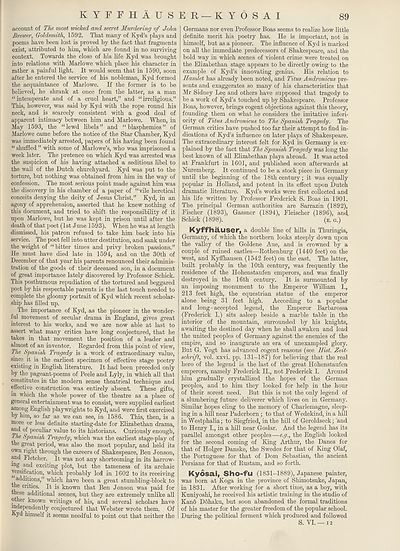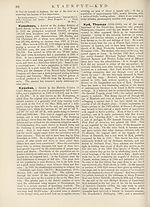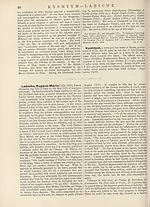New volumes of the Encyclopædia Britannica > Volume 30, K-MOR
(111) Page 89
Download files
Complete book:
Individual page:
Thumbnail gallery: Grid view | List view

KYFFHAUSER — KYOSAI
account of The most wicked and secret Murdering of John
Brewer, Goldsmith, 1592. That many of Kyd’s plays and
poems have been lost is proved by the fact that fragments
exist, attributed to him, which are found in no surviving
context. Towards the close of his life Kyd was brought
into relations with Marlowe which place his character in
rather a painful light. It would seem that in 1590, soon
after he entered the service of his nobleman, Kyd formed
the acquaintance of Marlowe. If the former is to be
believed, he shrank at once from the latter, as a man
“ intemperate and of a cruel heart,” and “ irreligious.”
This, however, was said by Kyd with the rope round his
neck, and is scarcely consistent with a good deal of
apparent intimacy between him and Marlowe. When, in
May 1593, the “lewd libels” and “blasphemies” of
Marlowe came before the notice of the Star Chamber, Kyd
was immediately arrested, papers of his having been found
“ shuffled ” with some of Marlowe’s, who was imprisoned a
week later. The pretence on which Kyd was arrested was
the suspicion of his having attached a seditious libel to
the wall of the Dutch churchyard. Kyd was put to the
torture, but nothing was obtained from him in the way of
confession. The most serious point made against him was
the discovery in his chamber of a paper of “vile heretical
conceits denying the deity of Jesus Christ.” Kyd, in an
agony of apprehension, asserted that he knew nothing of
this document, and tried to shift the responsibility of it
upon Marlowe, but he was kept in prison until after the
death of that poet (1st June 1593). When he was at length
dismissed, his patron refused to take him back into his
service. The poet fell into utter destitution, and sank under
the weight of “ bitter times and privy broken passions.”
He must have died late in 1594, and on the 30th of
December of that year his parents renounced their adminis¬
tration of the goods of their deceased son, in a document
of great importance lately discovered by Professor Schick.
This posthumous repudiation of the tortured and beggared
poet by his respectable parents is the last touch needed to
complete the gloomy portrait of Kyd which recent scholar¬
ship has filled up.
The importance of Kyd, as the pioneer in the wonder¬
ful movement of secular drama in England, gives great
interest to his works, and we are now able at last to
assert what many critics have long conjectured, that he
takes in that movement the position of a leader and
almost of an inventor. Regarded from this point of view,
The Spanish Tragedy is a work of extraordinary value,
since it is the earliest specimen of effective stage poetry
existing in English literature. It had been preceded only
by the pageant-poems of Peele and Lyly, in which all that
constitutes in the modern sense theatrical technique and
effective construction was entirely absent. These gifts,
in which the whole power of the theatre as a place of
general entertainment was to consist, were supplied earliest
among English playwrights to Kyd, and were first exercised
by him, so far as we can see, in 1586. This, then, is a
more or less definite starting-date for Elizabethan drama,
and of peculiar value to its historians. Curiously enough,
The Spanish Tragedy, which was the earliest stage-play of
the great period, was also the most popular, and held its
own right through the careers of Shakespeare, Ben Jonson,
and Fletcher. It was not any shortcoming in its harrow-
mg and exciting plot, but the tameness of its archaic
versification, which probably led in 1602 to its receiving
additions,” which have been a great stumbling-block to
the critics. It is known that Ben Jonson was paid for
these additional scenes, but they are extremely unlike all
other known writings of his, and several scholars have
mdependently conjectured that Webster wrote them. Of
Kyd himself it seems needful to point out that neither the
89
Germans nor even Professor Boas seems to realize how little
definite merit his poetry has. He is important, not in
himself, but as a pioneer. The influence of Kyd is marked
on all the immediate predecessors of Shakespeare, and the
bold way in which scenes of violent crime were treated on
the Elizabethan stage appears to be directly owing to the
example of Kyd’s innovating genius. His relation to
Hamlet has already been noted, and Titus Andronicus pre¬
sents and exaggerates so many of his characteristics that
Mr Sidney Leo and others have supposed that tragedy to
be a work of Kyd’s touched up by Shakespeare. Professor
Boas, however, brings cogent objections against this theory,
founding them on what he considers the imitative inferi¬
ority of Titus Andronicus to The Spanish Tragedy. The
German critics have pushed too far their attempt to find in¬
dications of Kyd’s influence on later plays of Shakespeare.
The extraordinary interest felt for Kyd in Germany is ex¬
plained by the fact that The Spanish Tragedy was long the
best known of all Elizabethan plays abroad. It was acted
at Frankfurt in 1601, and published soon afterwards at
Nuremberg. It continued to be a stock piece in Germany
until the beginning of the 18th century; it was equally
popular in Holland, and potent in its effect upon Dutch
dramatic literature. Kyd’s works were first collected and
his life written by Professor Frederick S. Boas in 1901.
The principal German authorities are Sarrazin (1892),
Fischer (1893), Gassner (1894), Fleischer (1896), and
Schick (1898). (e. g.)
Kyffhauser, a double line of hills in Thuringia,
Germany, of which the northern looks steeply down upon
the valley of the Goldene Aue, and is crowned by a
couple of ruined castles—Rothenburg (1440 feet) on the
west, and Kyffhausen (1542 feet) on the east. The latter,
built probably in the 10th century, was frequently the
residence of the Hohenstaufen emperors, and was finally
destroyed in the 16th century. It is surmounted by
an imposing monument to the Emperor William I.,
213 feet high, the equestrian statue of the emperor
alone being 31 feet high. According to a popular
and long - accepted legend, the Emperor Barbarossa
(Frederick I.) sits asleep beside a marble table in the
interior of the mountain, surrounded by his knights,
awaiting the destined day when he shall awaken and lead
the united peoples of Germany against the enemies of the
empire, and so inaugurate an era of unexampled glory.
But G. Vogt has advanced cogent reasons (see Hist. Zeit-
schrift, vol. xxvi. pp. 131-187) for believing that the real
hero of the legend is the last of the great Hohenstaufen
emperors, namely Frederick II., not Frederick I. Around
him gradually crystallized the hopes of the German
peoples, and to him they looked for help in the hour
of their sorest need. But this is not the only legend of
a slumbering future deliverer which lives on in Germany.
Similar hopes cling to the memory of Charlemagne, sleep¬
ing in a hill near Paderborn ; to that of Wedekind, in a hill
in Westphalia; to Siegfried, in the hill of Geroldseck; and
to Henry L, in a hill near Goslar. And the legend has its
parallel amongst other peoples—e.g., the English looked
for the second coming of King Arthur, the Danes for
that of Holger Danske, the Swedes for that of King Olaf,
the Portuguese for that of Dom Sebastian, the ancient
Persians for that of Rustam, and so forth.
Kyosai, Sho-fu (1831-1889), Japanese painter,
was born at Koga in the province of Shimotsuke, Japan,
in 1831. After working for a short time, as a boy, with
Kuniyoshi, he received his artistic training in the studio of
Kan6 Dohaku, but soon abandoned the formal traditions
of his master for the greater freedom of the popular school.
During the political ferment which produced and followed
S. VI.—12
account of The most wicked and secret Murdering of John
Brewer, Goldsmith, 1592. That many of Kyd’s plays and
poems have been lost is proved by the fact that fragments
exist, attributed to him, which are found in no surviving
context. Towards the close of his life Kyd was brought
into relations with Marlowe which place his character in
rather a painful light. It would seem that in 1590, soon
after he entered the service of his nobleman, Kyd formed
the acquaintance of Marlowe. If the former is to be
believed, he shrank at once from the latter, as a man
“ intemperate and of a cruel heart,” and “ irreligious.”
This, however, was said by Kyd with the rope round his
neck, and is scarcely consistent with a good deal of
apparent intimacy between him and Marlowe. When, in
May 1593, the “lewd libels” and “blasphemies” of
Marlowe came before the notice of the Star Chamber, Kyd
was immediately arrested, papers of his having been found
“ shuffled ” with some of Marlowe’s, who was imprisoned a
week later. The pretence on which Kyd was arrested was
the suspicion of his having attached a seditious libel to
the wall of the Dutch churchyard. Kyd was put to the
torture, but nothing was obtained from him in the way of
confession. The most serious point made against him was
the discovery in his chamber of a paper of “vile heretical
conceits denying the deity of Jesus Christ.” Kyd, in an
agony of apprehension, asserted that he knew nothing of
this document, and tried to shift the responsibility of it
upon Marlowe, but he was kept in prison until after the
death of that poet (1st June 1593). When he was at length
dismissed, his patron refused to take him back into his
service. The poet fell into utter destitution, and sank under
the weight of “ bitter times and privy broken passions.”
He must have died late in 1594, and on the 30th of
December of that year his parents renounced their adminis¬
tration of the goods of their deceased son, in a document
of great importance lately discovered by Professor Schick.
This posthumous repudiation of the tortured and beggared
poet by his respectable parents is the last touch needed to
complete the gloomy portrait of Kyd which recent scholar¬
ship has filled up.
The importance of Kyd, as the pioneer in the wonder¬
ful movement of secular drama in England, gives great
interest to his works, and we are now able at last to
assert what many critics have long conjectured, that he
takes in that movement the position of a leader and
almost of an inventor. Regarded from this point of view,
The Spanish Tragedy is a work of extraordinary value,
since it is the earliest specimen of effective stage poetry
existing in English literature. It had been preceded only
by the pageant-poems of Peele and Lyly, in which all that
constitutes in the modern sense theatrical technique and
effective construction was entirely absent. These gifts,
in which the whole power of the theatre as a place of
general entertainment was to consist, were supplied earliest
among English playwrights to Kyd, and were first exercised
by him, so far as we can see, in 1586. This, then, is a
more or less definite starting-date for Elizabethan drama,
and of peculiar value to its historians. Curiously enough,
The Spanish Tragedy, which was the earliest stage-play of
the great period, was also the most popular, and held its
own right through the careers of Shakespeare, Ben Jonson,
and Fletcher. It was not any shortcoming in its harrow-
mg and exciting plot, but the tameness of its archaic
versification, which probably led in 1602 to its receiving
additions,” which have been a great stumbling-block to
the critics. It is known that Ben Jonson was paid for
these additional scenes, but they are extremely unlike all
other known writings of his, and several scholars have
mdependently conjectured that Webster wrote them. Of
Kyd himself it seems needful to point out that neither the
89
Germans nor even Professor Boas seems to realize how little
definite merit his poetry has. He is important, not in
himself, but as a pioneer. The influence of Kyd is marked
on all the immediate predecessors of Shakespeare, and the
bold way in which scenes of violent crime were treated on
the Elizabethan stage appears to be directly owing to the
example of Kyd’s innovating genius. His relation to
Hamlet has already been noted, and Titus Andronicus pre¬
sents and exaggerates so many of his characteristics that
Mr Sidney Leo and others have supposed that tragedy to
be a work of Kyd’s touched up by Shakespeare. Professor
Boas, however, brings cogent objections against this theory,
founding them on what he considers the imitative inferi¬
ority of Titus Andronicus to The Spanish Tragedy. The
German critics have pushed too far their attempt to find in¬
dications of Kyd’s influence on later plays of Shakespeare.
The extraordinary interest felt for Kyd in Germany is ex¬
plained by the fact that The Spanish Tragedy was long the
best known of all Elizabethan plays abroad. It was acted
at Frankfurt in 1601, and published soon afterwards at
Nuremberg. It continued to be a stock piece in Germany
until the beginning of the 18th century; it was equally
popular in Holland, and potent in its effect upon Dutch
dramatic literature. Kyd’s works were first collected and
his life written by Professor Frederick S. Boas in 1901.
The principal German authorities are Sarrazin (1892),
Fischer (1893), Gassner (1894), Fleischer (1896), and
Schick (1898). (e. g.)
Kyffhauser, a double line of hills in Thuringia,
Germany, of which the northern looks steeply down upon
the valley of the Goldene Aue, and is crowned by a
couple of ruined castles—Rothenburg (1440 feet) on the
west, and Kyffhausen (1542 feet) on the east. The latter,
built probably in the 10th century, was frequently the
residence of the Hohenstaufen emperors, and was finally
destroyed in the 16th century. It is surmounted by
an imposing monument to the Emperor William I.,
213 feet high, the equestrian statue of the emperor
alone being 31 feet high. According to a popular
and long - accepted legend, the Emperor Barbarossa
(Frederick I.) sits asleep beside a marble table in the
interior of the mountain, surrounded by his knights,
awaiting the destined day when he shall awaken and lead
the united peoples of Germany against the enemies of the
empire, and so inaugurate an era of unexampled glory.
But G. Vogt has advanced cogent reasons (see Hist. Zeit-
schrift, vol. xxvi. pp. 131-187) for believing that the real
hero of the legend is the last of the great Hohenstaufen
emperors, namely Frederick II., not Frederick I. Around
him gradually crystallized the hopes of the German
peoples, and to him they looked for help in the hour
of their sorest need. But this is not the only legend of
a slumbering future deliverer which lives on in Germany.
Similar hopes cling to the memory of Charlemagne, sleep¬
ing in a hill near Paderborn ; to that of Wedekind, in a hill
in Westphalia; to Siegfried, in the hill of Geroldseck; and
to Henry L, in a hill near Goslar. And the legend has its
parallel amongst other peoples—e.g., the English looked
for the second coming of King Arthur, the Danes for
that of Holger Danske, the Swedes for that of King Olaf,
the Portuguese for that of Dom Sebastian, the ancient
Persians for that of Rustam, and so forth.
Kyosai, Sho-fu (1831-1889), Japanese painter,
was born at Koga in the province of Shimotsuke, Japan,
in 1831. After working for a short time, as a boy, with
Kuniyoshi, he received his artistic training in the studio of
Kan6 Dohaku, but soon abandoned the formal traditions
of his master for the greater freedom of the popular school.
During the political ferment which produced and followed
S. VI.—12
Set display mode to:
![]() Universal Viewer |
Universal Viewer | ![]() Mirador |
Large image | Transcription
Mirador |
Large image | Transcription
Images and transcriptions on this page, including medium image downloads, may be used under the Creative Commons Attribution 4.0 International Licence unless otherwise stated. ![]()
| Encyclopaedia Britannica > New volumes of the Encyclopædia Britannica > Volume 30, K-MOR > (111) Page 89 |
|---|
| Permanent URL | https://digital.nls.uk/193568944 |
|---|
| Attribution and copyright: |
|
|---|---|
| Shelfmark | EB.18 |
|---|---|
| Description | Ten editions of 'Encyclopaedia Britannica', issued from 1768-1903, in 231 volumes. Originally issued in 100 weekly parts (3 volumes) between 1768 and 1771 by publishers: Colin Macfarquhar and Andrew Bell (Edinburgh); editor: William Smellie: engraver: Andrew Bell. Expanded editions in the 19th century featured more volumes and contributions from leading experts in their fields. Managed and published in Edinburgh up to the 9th edition (25 volumes, from 1875-1889); the 10th edition (1902-1903) re-issued the 9th edition, with 11 supplementary volumes. |
|---|---|
| Additional NLS resources: |
|

